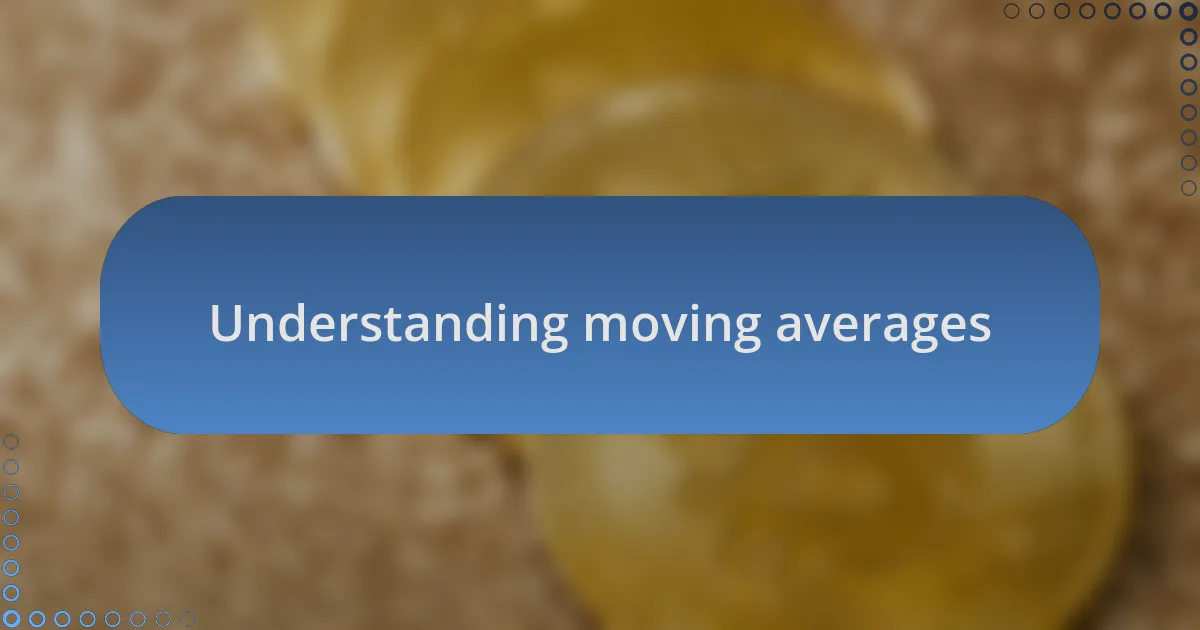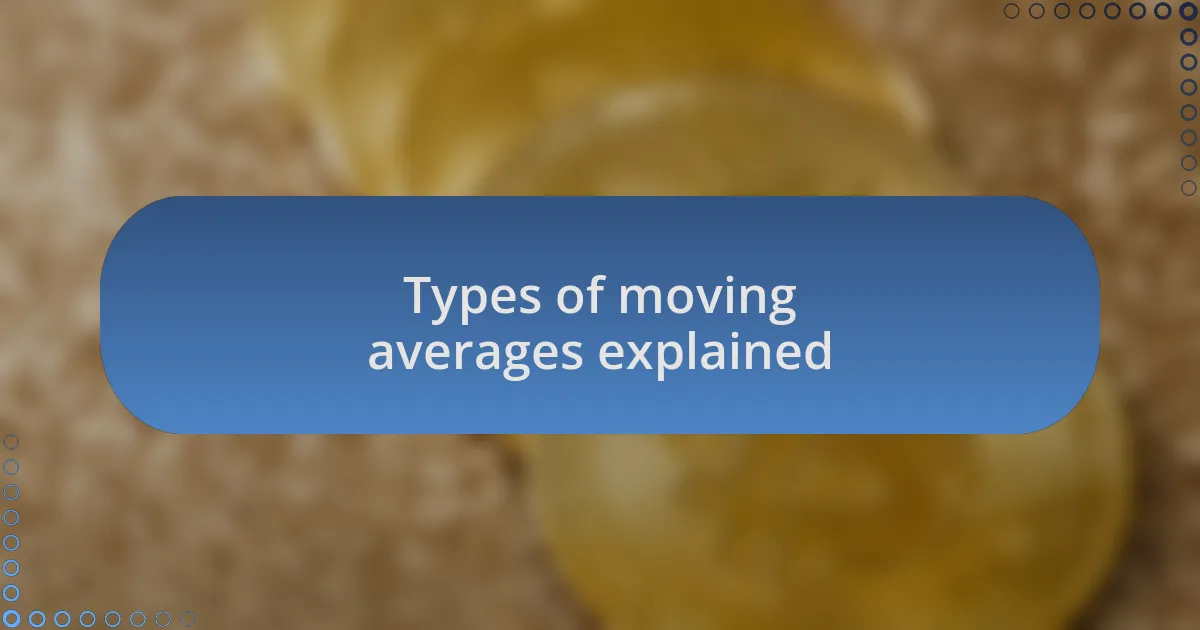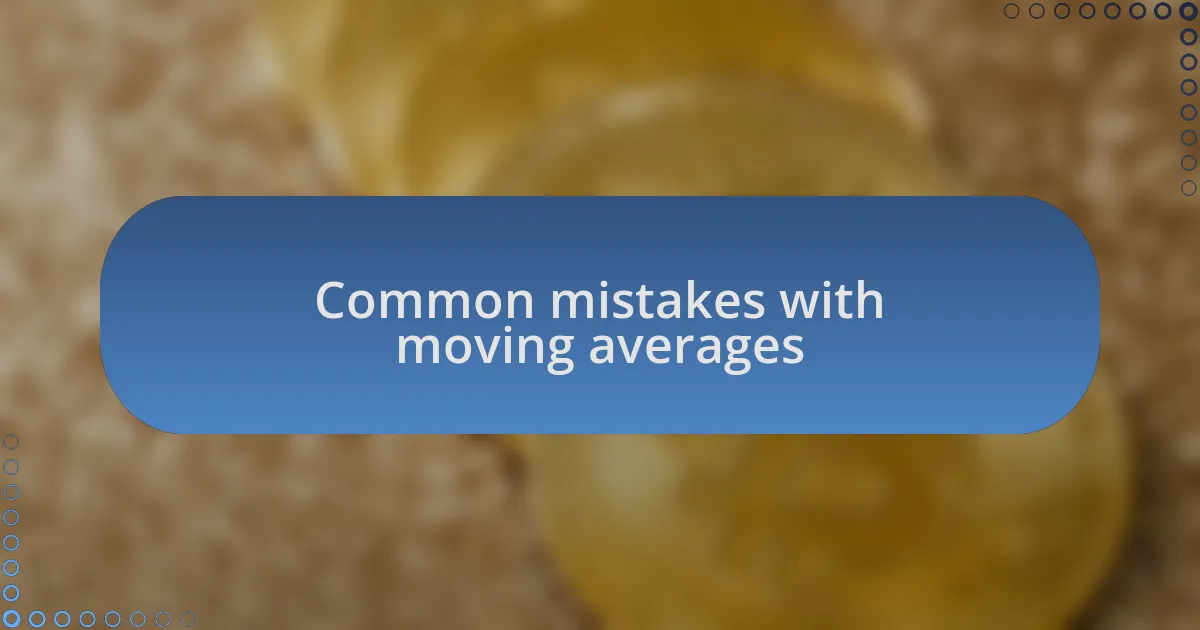Key takeaways:
- Moving averages are essential in technical analysis, helping to identify trends by smoothing out price data.
- The exponential moving average (EMA) is more responsive to recent price changes, making it useful in volatile markets.
- Combining moving averages with other indicators, like the RSI, enhances trading strategies and promotes patience.
- Common mistakes include overemphasis on short-term signals and misunderstanding the differences between moving average types.

Understanding moving averages
Moving averages are fundamental tools in technical analysis that help smooth out price data and identify trends over time. I remember the first time I used a simple moving average; it was like having a clearer lens through which to view market fluctuations. Instead of getting caught up in the daily noise, I was able to focus on the bigger picture.
The concept of a moving average is straightforward, yet it can be powerful. I often ask myself, “How can I make sense of all this market movement?” By applying a moving average, I can gauge whether a cryptocurrency is trending upward or downward, helping me make informed decisions. It’s fascinating how a number calculated from past prices can shape my trading strategy.
As I explored different types of moving averages, such as the exponential moving average, I found that each has its own edge. For instance, the exponential moving average places more weight on recent prices, which I’ve found particularly useful during volatile market conditions. Have you ever thought about how slight variations in these calculations can significantly impact your trading outcomes? Understanding these nuances can be the difference between a successful trade and a missed opportunity.

Types of moving averages explained
Just like any analytical tool, moving averages come in different forms, each with unique benefits. The simple moving average (SMA) is the most basic type; it calculates the average price over a specified number of periods. I remember using the SMA during a period of market consolidation. It helped me visualize support and resistance levels clearly, revealing insights I might have otherwise missed.
On the other hand, the exponential moving average (EMA) provides a more responsive approach to price changes. I was once caught in a fast-moving market where the EMA was a lifesaver. It allowed me to enter trades timely as it reacted more quickly to recent price shifts, making it a staple in my trading toolkit. Have you considered how quickly you need to adapt your strategy in today’s crypto market?
Then there’s the weighted moving average (WMA), which gives different weights to data points based on their relevance. This type resonates with me because it emphasizes recent price action while softening older data’s impact. I recall a time when this approach helped me dodge a significant downturn because I was keenly aware of the latest trends rather than being clouded by outdated information. Selecting the right type of moving average ultimately depends on your trading style and objectives.

How I apply moving averages
When it comes to applying moving averages in my trading, I rely heavily on the crossover strategy. I remember a time when the 50-day EMA crossed above the 200-day EMA, a classic golden cross. That moment not only heightened my excitement but also prompted me to take a position, leading to a profitable trade that reinforced my belief in the power of this strategy. Have you ever experienced that thrill when a clear signal emerges?
I often combine moving averages with other indicators, creating what I call my “confirmation system.” On a particularly volatile day, I paired the EMA with the Relative Strength Index (RSI). The confluence of these indicators indicated an overbought condition, prompting me to resist the urge to enter a long position and instead wait for a clearer pullback signal. This practice has taught me patience and the importance of not solely relying on a single metric.
Additionally, I use moving averages to identify trends in longer time frames. Once, during a bear market, I adjusted my focus from daily to weekly moving averages. This shift helped me maintain perspective and avoid knee-jerk reactions to temporary fluctuations. By watching the overall trend rather than getting caught up in short-term noise, I found clarity and direction in my trading decisions. How do you balance short-term and long-term strategies?

Common mistakes with moving averages
One common mistake I often see traders make with moving averages is placing too much emphasis on short-term crossovers without considering the bigger picture. I remember a time when I got overly excited about a quick crossover signal, only to watch it quickly reverse. This experience taught me that without context—like understanding market trends or broader economic indicators—those signals can lead to impulsive decisions that don’t align with the overall market sentiment.
Another pitfall I’ve encountered is the misunderstanding of moving average types. I once mixed up exponential moving averages (EMAs) with simple moving averages (SMAs), and it dramatically altered my trading decisions. The EMA reacts faster to price changes, but the SMA offers a more stable view. That difference can mean the world in volatile markets like crypto. So, are you clear on how different moving averages can impact your strategy?
Lastly, failing to adapt the moving average period to your specific trading style can be detrimental. Early on, I stuck to the standard periods like 50 and 200 days, regardless of the asset’s characteristics. It wasn’t until I tested shorter periods for day trading and longer ones for swing trading that I truly understood their potential. This adaptability is crucial—are you tailoring your moving averages to fit your trading approach?